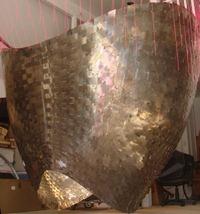Prototyping a Self-Ventilating Building Skin with Smart Thermobimetals

Challenging the traditional presumption that a building skin should be static and inanimate, this investigation examines the replacement of this convention with a responsive system that is a prosthetic extension of human and a mediator for the environment. With the emergence of smart materials, an elevated interest in utilizing unconventional building systems and an urgent need to build sustainable structures, our buildings can be more sensitive to the environment and the human body, raising the level of effectiveness while altering our perception of enclosure. To test this thesis, an 8’ tall portable prototype with a responsive, self-ventilating building skin using sheet thermobimetal, a smart material never before used in building skins, was built. By laminating two metal alloys with different coefficients of expansion together, the result is a thermobimetal that curls when heated and flattens when cooled. As the temperature rises, this deformation will allow the building skin to breathe much like the pores in human skin.


Add comment
Log in to post comments